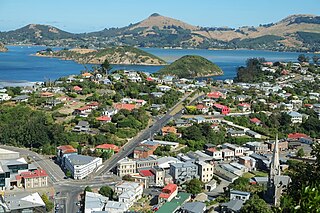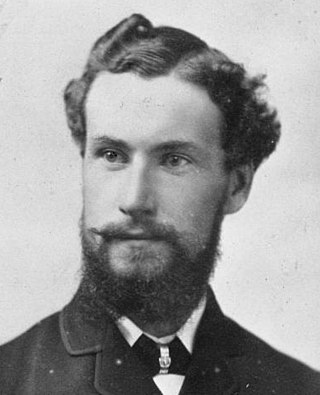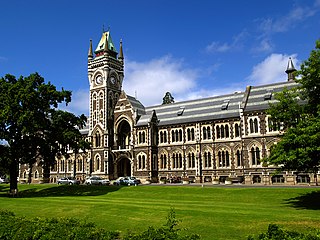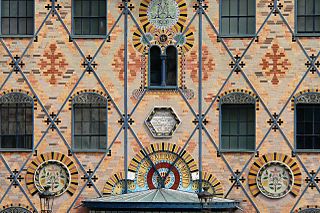
Port Chalmers is a town serving as the main port of the city of Dunedin, New Zealand. Port Chalmers lies ten kilometres inside Otago Harbour, some 15 kilometres northeast of Dunedin's city centre.

William Henry Clayton was a Tasmanian-born colonial architect who practised initially in Tasmania and then in New Zealand. He was New Zealand's first Colonial Architect, serving in the position from 1869 up until his death. In this role, he and his office were responsible for the design of numerous government buildings.

The Dunedin School of Medicine is the name of the School of Medicine that is based on the Dunedin campus of the University of Otago. All University of Otago medical students who gain entry after the competitive Health Sciences First Year program, or who gain graduate entry, spend their second and third years studying at the Otago Medical School in Dunedin. In their fourth, fifth, and sixth years, students can either study at the Dunedin School of Medicine (Dunedin), the University of Otago, Christchurch, or the University of Otago, Wellington.

Princes Street is a major street in Dunedin, the second largest city in the South Island of New Zealand. It runs south-southwest for two kilometres from The Octagon in the city centre to the Oval sports ground, close to the city's Southern Cemetery. North of The Octagon, George Street continues the line of Princes Street north-northeast for two and a half kilometres. Princes Street is straight but undulating, skirting the edge of the City Rise to its northwest. The part of the street immediately below The Octagon is the steepest section, as the road traverses an old cutting through Bell Hill.

Otago Polytechnic is a public New Zealand tertiary education institute, centred in Dunedin with additional campuses in Cromwell and Auckland. Otago Polytechnic provides career-focused education and training, offering a range of New Zealand accredited postgraduate qualifications, degrees, diplomas and certificates at levels 2–10. In November 2022, it became a business unit of the national mega polytechnic Te Pūkenga, ending its existence as an independent entity.

Robert Arthur Lawson was one of New Zealand's pre-eminent 19th century architects. The Dictionary of New Zealand Biography states that he did more than any other designer to shape the face of the Victorian era architecture of the city of Dunedin. He is the architect of over forty churches, including Dunedin's First Church for which he is best remembered, but also other buildings, such as Larnach Castle, a country house, with which he is also associated.

William Mason was a New Zealand architect born in Ipswich, England, the son of an architect/builder George Mason and Susan, née Forty. Trained by his father he went to London where he seems to have worked for Thomas Telford (1757–1834). He studied under Peter Nicholson (1765–1844) before eventually working for Edward Blore (1787–1879).
Architecture of New Zealand is the built environment of regions, cities and towns of New Zealand.
Edward John McCoy, generally known as Ted McCoy, was a New Zealand architect whose practice was based in Dunedin. He designed the sanctuary of St Paul's Cathedral, and the Richardson Building of the University of Otago, among many others. In 1950, he established McCoy and Wixon Architects, joined in partnership by Peter Wixon in 1967.

John Campbell was a New Zealand architect, responsible for many government buildings in New Zealand, among them the Dunedin Law Courts, the Public Trust Building in Wellington, and Parliament House. From 1909 until his retirement in 1922 he held the position of government architect.

The University of Otago Clocktower complex is a group of architecturally and historically significant buildings in the centre of the University of Otago campus. Founded in Dunedin, New Zealand, in 1869, the University of Otago was the expression of the province's Scottish founders' commitment to higher education. They were also the inheritors of a strong architectural tradition and gritty determination. Defending the decision to build in expensive materials in an elaborate historicizing manner, the chancellor, Donald Stuart, said "the Council had some old-world notions and liked to have a university with some architectural style". This attitude persisted for over 50 years and resulted in an impressive group of buildings.

Maxwell Bury was an English-born architect who was active in New Zealand in the 19th century. He is best remembered for his buildings for the University of Otago.

The Exchange is an area of central Dunedin, in the South Island of New Zealand.
Hugh Joseph Finn was a 19th-century Member of Parliament in the Otago region of New Zealand.

All Saints' Church is a heritage-listed Anglican church located in Dunedin, New Zealand. Established in 1865, the church is part of the Dunedin North parish in the Diocese of Dunedin.

Polychrome brickwork is a style of architectural brickwork in which bricks of different colours are used to create decorative patterns or highlight architectural features in the walls of a building. Historically it was used in the late Gothic period in Europe, and the Tudor period in England. This style was revived in Britain in the 1850s as a feature of Gothic Revival architecture. Later, in the 19th century and into the early 20th century it was adopted in various forms in Europe for all manner of buildings such as French eclectic villas, Dutch row houses, and German railway stations, and as far away as Melbourne, Australia, where the technique reached heights of popularity and elaboration in the 1880s.

The Wains Hotel Building is a historic hotel building in Dunedin, New Zealand.

Henry Thomas Mandeno was a New Zealand modernist architect.
















